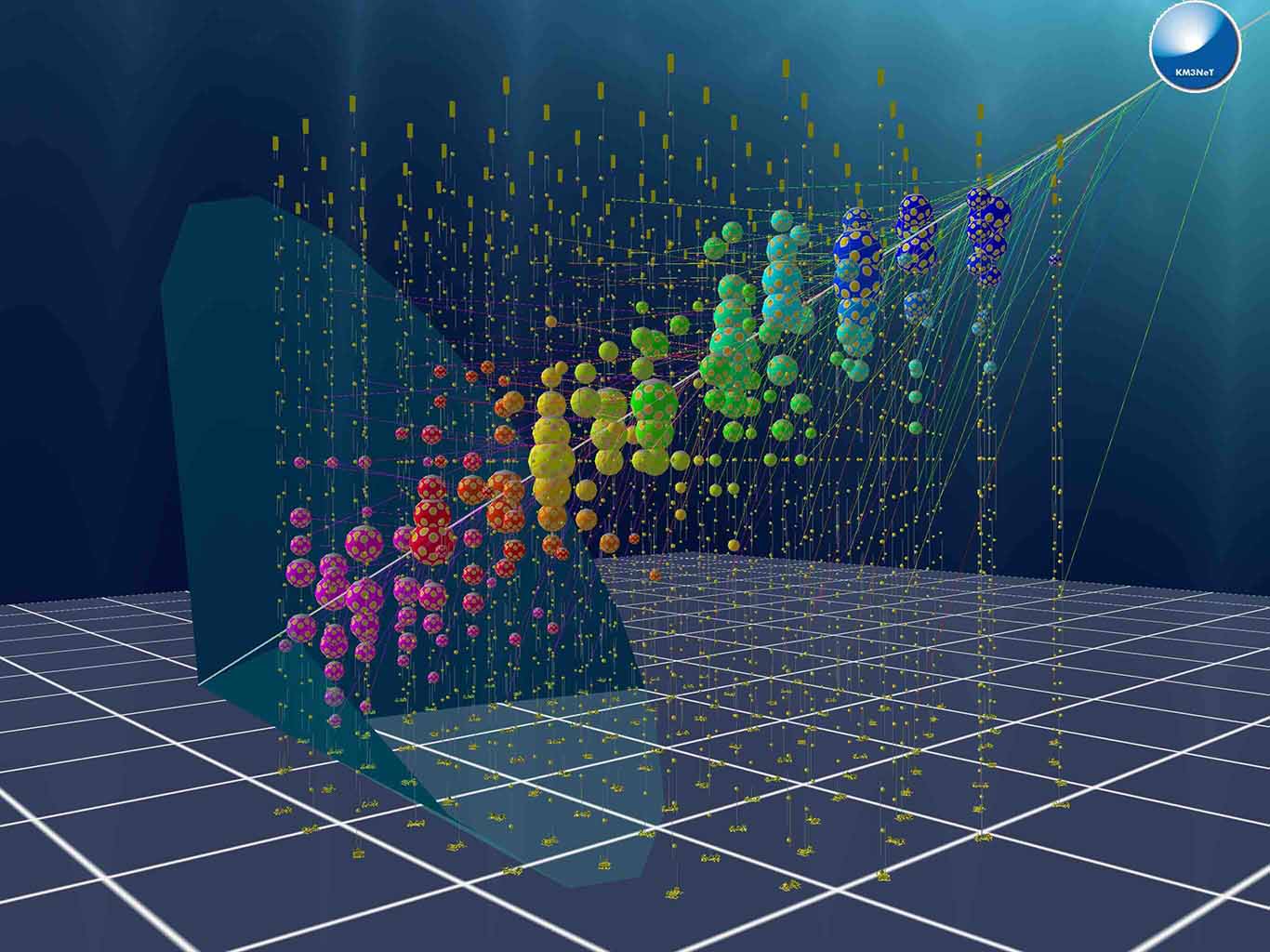The most energetic neutrino ever recorded offers the first evidence that such high-energy particles occur naturally in our universe, thanks to a deep-sea sensor off the coast of Europe.
Estimated to carry an astonishing 220 peta-electron volts (PeV)—or 220 million billion electron volts—the neutrino was detected on February 13, 2023, by the Astroparticle Research with Cosmics in the Abyss (ARCA) detector, part of the Kilometer Cubic Neutrino Telescope (KM3NeT). Designated KM3-230213A, analyzing and interpreting the data from this event was a long and complex process for KM3NeT scientists.
A Single Particle Displays A Neutrino’s Power
The most energetic neutrino ever recorded offers the first evidence that such high-energy particles occur naturally in our universe, thanks to a deep-sea sensor off the coast of Europe.
Estimated to carry an astonishing 220 peta-electron volts (PeV)—or 220 million billion electron volts—the neutrino was detected on February 13, 2023, by the Astroparticle Research with Cosmics in the Abyss (ARCA) detector, part of the Kilometer Cubic Neutrino Telescope (KM3NeT). Designated KM3-230213A, analyzing and interpreting the data from this event was a long and complex process for KM3NeT scientists.
“KM3NeT has begun to probe a range of energy and sensitivity where detected neutrinos may originate from extreme astrophysical phenomena. This first-ever detection of a neutrino of hundreds of PeV opens a new chapter in neutrino astronomy and a new observational window on the Universe”, said KM3NeT spokesperson Paschal Coyle.
Mysterious Powers Lurk In Our Universe
The universe’s high-energy activities remain some of its most mysterious, which include the accretion of supermassive black holes, supernova explosions, and gamma-ray bursts. These powerful events generate cosmic rays, some of which interact with matter or photons to create neutrinos. A portion of the most high-energy cosmic rays run into cosmic background radiation on their journey, interacting with photons there to produce highly energetic “cosmogenic” neutrinos.
“Neutrinos are one of the most mysterious of elementary particles. They have no electric charge, almost no mass, and interact only weakly with matter. They are special cosmic messengers, bringing us unique information on the mechanisms involved in the most energetic phenomena and allowing us to explore the farthest reaches of the Universe”, explains Rosa Coniglione, KM3NeT deputy spokesperson.
Detecting Cosmic Neutrinos From The Deep Sea
Despite their abundance in the universe, detecting neutrinos is challenging due to their faint characteristics. While the KM3NeT neutrino telescope is already responsible for this discovery, the observation platform is still under construction and is planned to expand to over one cubic kilometer.
The platform’s twin detectors, ARCA and the Oscillation Research with Cosmics in the Abyss (ORCA), use the water in their deep-sea locations as a medium to detect neutrinos. When the neutrinos travel through seawater, they produce a bluish glow called Cherenkov light, which the ARCA and ORCA optical sensors can pick up.
“To determine the direction and energy of this neutrino required a precise calibration of the telescope and sophisticated track reconstruction algorithms. Furthermore, this remarkable detection was achieved with only one-tenth of the final configuration of the detector, demonstrating the great potential of our experiment for the study of neutrinos and for neutrino astronomy,” said Aart Heijboer, KM3NeT Physics, and Software Manager of the team’s detection.
The KM3NeT Neutrino Detection Apparatus
KM3NeT’s twin detectors each provide a slightly different specialization to advance from the identification phase into analysis. ARCA, roughly 80km off the coast of Portopalo di Capo Passero, Sicily, is primarily focused on observing the highest-energy neutrinos and their sources. The station sits 3450 meters below the surface, comprised of 700-meter-high detection units anchored to the sea floor, spread out 100 meters apart, with underwater cables transmitting the data to the INFN Laboratori Nazionali del Sud.
By contrast, the ORCA detector has a different mission, optimized to study a neutrino’s properties. This station will eventually include 115 DUs, 200 meters high with a 20-meter spacing 40 km off the coast of Toulon, France, sending data to a different shore station, La Seyne Sur Mer.
“The scale of KM3NeT, eventually encompassing a volume of about one cubic kilometer with a total of about 200,000 photomultipliers, along with its extreme location in the abyss of the Mediterranean Sea, demonstrates the extraordinary efforts required to advance neutrino astronomy and particle physics. The detection of this event is the result of a tremendous collaborative effort between many international teams of engineers, technicians, and scientists,” said Miles Lindsey Clark, KM3NeT Technical Project Manager at the time of the detection.
Neutrino Detection Continues
Scientists at KM3NeT remain unclear about the exact nature of the ultra-high-energy neutrino. They hypothesize that the neutrino originated directly from a powerful cosmic accelerator, or that it is the first detection of a cosmogenic neutrino birthed from cosmic rays interacting with the cosmic background radiation.
As KM3NeT expands its efforts, the institution will gather additional data to clarify the scientific understanding of the neutrino enigma.
The paper “Observation of an Ultra-High-Energy Cosmic Neutrino with KM3NeT” appeared on February 12, 2025 in Nature.
Ryan Whalen covers science and technology for The Debrief. He holds an MA in History and a Master of Library and Information Science with a certificate in Data Science. He can be contacted at ryan@thedebrief.org, and follow him on Twitter @mdntwvlf.

